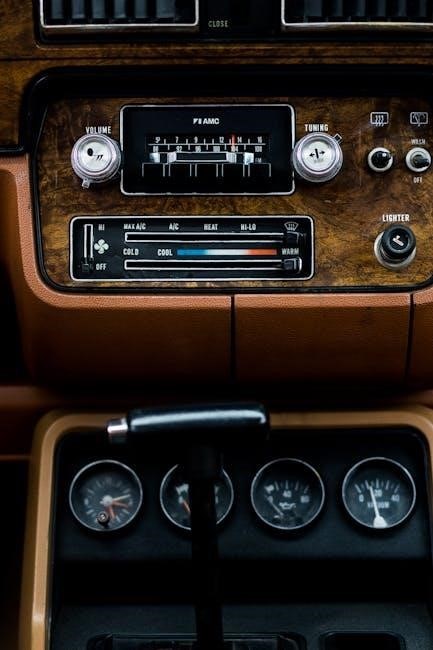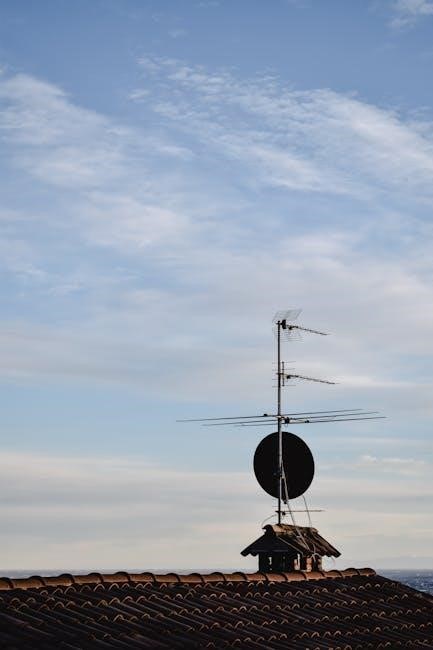Can You Put a Remote Start on a Manual Transmission?
Yes, you can install a remote start on a manual transmission vehicle, but it requires careful consideration․ The car must be in neutral gear, and the handbrake must be engaged to ensure safety․ Specialized systems, like those from Compustar or Viper, are designed to handle manual transmissions safely․ Professional installation is highly recommended to avoid potential risks and ensure proper functionality․
Remote start technology has become increasingly popular, offering drivers the convenience of starting their vehicles from a distance․ While this feature is commonly associated with automatic transmissions, many car owners wonder if it can be installed on manual transmission vehicles․ The answer is yes, but with specific considerations․ Manual transmissions require additional safety measures to prevent unintended movement when the engine starts remotely․ Key factors include ensuring the vehicle is in neutral gear and the handbrake is engaged․ Modern remote start systems, such as those from Compustar and Viper, are designed to address these challenges․ However, improper installation or misuse can lead to safety risks․ This article explores the feasibility, safety concerns, and installation requirements for remote start systems on manual transmission vehicles, providing insights for car owners seeking to add this convenient feature․ By understanding the process and precautions, drivers can enjoy the benefits of remote starting while maintaining safety and vehicle integrity․
Feasibility of Remote Start on Manual Transmissions
Installing a remote start on a manual transmission vehicle is feasible, but it requires specific precautions and technologies to ensure safe operation․ Unlike automatic transmissions, which automatically check if the vehicle is in park, manual transmissions need additional mechanisms to confirm the car is in neutral and the handbrake is engaged․ Modern remote start systems, such as those from Compustar and Viper, are equipped with sensors and algorithms to verify these conditions before starting the engine․ These systems often include clutch pedal simulation, allowing the engine to start without manual clutch engagement․ Additionally, some systems require the driver to activate a “reservation mode” before leaving the vehicle, ensuring the car is properly prepared for remote starting․ While the process is more complex than with automatic transmissions, advancements in technology have made remote starts on manual vehicles both practical and safe, provided proper installation and usage guidelines are followed․ This ensures that the convenience of remote starting is accessible to manual transmission drivers without compromising safety or vehicle functionality․
Key Considerations for Remote Start Installation
Installing a remote start on a manual transmission vehicle involves several critical considerations to ensure safe and proper functionality․ First, the system must verify that the vehicle is in neutral gear and that the handbrake is engaged before starting the engine․ This prevents the car from moving unexpectedly when started remotely․ Additionally, specialized remote start systems designed for manual transmissions are required, as they include features like clutch pedal simulation or reservation mode activation․ These systems ensure the engine can start without manual clutch engagement while maintaining safety․ It is also important to choose a reputable brand, such as Compustar or Viper, which offers manual-transmission-compatible remote start solutions․ Professional installation is highly recommended, as improper setup can lead to vehicle damage or safety hazards․ Furthermore, the installation must comply with the vehicle’s warranty and manufacturer guidelines to avoid voiding any coverage․ Always consult a certified technician to ensure the remote start system is installed correctly and functions safely with your manual transmission vehicle․
Safety Concerns and Liability
Installing a remote start on a manual transmission vehicle raises significant safety concerns and liability issues․ If the system is not properly configured, the vehicle could accidentally move, causing damage or injury․ This is particularly risky if the car is not in neutral gear or the handbrake is not fully engaged․ Manufacturers and installers must ensure the system includes fail-safes to prevent such incidents․ For example, the vehicle should only start if it confirms the transmission is in neutral and the handbrake is applied․ Misuse of a remote start system can lead to legal liability for the vehicle owner or installer, especially if an accident occurs due to improper installation or operation․
Additionally, some manufacturers may void warranties if aftermarket remote start systems are installed incorrectly․ It is crucial to use systems specifically designed for manual transmissions and follow all safety protocols․ Professional installation is highly recommended to minimize risks and ensure compliance with safety standards․ Always consult a certified technician to address these concerns and avoid potential legal or financial repercussions․
How Remote Start Systems Work on Manual Transmissions
Remote start systems for manual transmissions operate by bypassing the clutch pedal or simulating its engagement to initiate engine startup․ These systems typically include specialized components, such as clutch bypass modules or sensors, to ensure safe and proper operation․ When activated, the remote start system first verifies that the vehicle is in neutral gear and that the handbrake is engaged, preventing unintended movement․
The system then sends an electronic signal to the ignition and fuel systems, mimicking the process of turning the key or pressing the start button․ Some advanced systems, like those from Compustar, use electronic actuators to depressed the clutch pedal momentarily, allowing the engine to start without manual intervention․ Once the engine is running, the system ensures the vehicle remains stationary by monitoring its status․
Reservation mode is often required to activate the remote start․ This involves a specific sequence of actions, such as pressing the brake pedal, shifting into neutral, and engaging the handbrake․ The system confirms these conditions before enabling remote start to ensure safety․ While these systems are designed to work seamlessly, proper installation and configuration are critical to avoid complications․
Special Requirements for Manual Transmissions
Installing a remote start on a manual transmission requires additional considerations to ensure safety and proper functionality․ The vehicle must be in neutral gear, and the handbrake must be fully engaged to prevent unintended movement․ Many systems also require a reservation mode to be activated before remote starting, which involves a specific sequence of actions, such as pressing the brake pedal, shifting into neutral, and engaging the handbrake․
Manual transmissions also require a mechanism to bypass the clutch pedal, as remote starting cannot physically press the clutch․ This is typically achieved through specialized components like clutch bypass modules or electronic actuators that simulate clutch engagement․ Some systems, such as those from Compustar, use advanced sensors to monitor the vehicle’s state and ensure it is safe to start remotely․
Professional installation is highly recommended for manual transmissions due to these complexities․ Improper installation can lead to safety hazards or damage to the vehicle․ Additionally, not all remote start systems are compatible with manual transmissions, so it’s essential to choose a system specifically designed for this purpose․ Popular brands like Viper and Compustar offer solutions tailored to manual vehicles, ensuring reliable performance and safety․ By meeting these requirements, remote start systems can provide convenience without compromising safety․
Role of Neutral Gear in Remote Start
The neutral gear plays a critical role in the safe operation of a remote start system on a manual transmission vehicle․ When the car is in neutral, the engine can start without the risk of the vehicle moving unexpectedly, as there is no connection between the engine and the wheels․ This ensures that the vehicle remains stationary even if the engine is running remotely․
Most remote start systems are designed to check the transmission’s status before engaging the starter motor․ If the vehicle is not in neutral, the system will typically prevent the engine from starting to avoid accidental movement․ This safety feature is essential for manual transmissions, where the absence of a park gear requires extra precautions to prevent the car from rolling or lurching forward․

Drivers must ensure the vehicle is shifted into neutral and the handbrake is engaged before attempting to remote start․ This step is crucial for preventing potential accidents or damage to the vehicle․ By relying on the neutral gear, remote start systems provide a safe and reliable way to start the engine of a manual transmission vehicle from a distance․ This feature is a cornerstone of remote start functionality for manual cars․
Importance of Handbrake Engagement
Engaging the handbrake is a critical safety measure when installing and using a remote start system on a manual transmission vehicle․ The handbrake ensures that the vehicle remains stationary even if the engine starts remotely, preventing any unintended movement․ This is especially important for manual transmissions, as the absence of a “park” gear means the vehicle could roll if not properly secured․
The handbrake acts as an additional layer of safety, complementing the neutral gear position․ Remote start systems often require the handbrake to be engaged as a failsafe to prevent accidental vehicle movement․ This ensures that the car cannot roll or lurch forward, even on an incline, while the engine is running remotely․
Modern remote start systems typically include sensors that verify the handbrake is engaged before allowing the engine to start․ This feature is designed to prevent potential accidents and damage to the vehicle or surrounding objects․ For manual transmissions, the handbrake engagement is a non-negotiable step in the remote start process․

Users should always follow the manufacturer’s guidelines for proper handbrake engagement when using a remote start system․ This ensures safe and reliable operation, avoiding risks associated with improper installation or usage․ The handbrake’s role in remote starting underscores its importance as a fundamental safety protocol for manual transmission vehicles․
Clutch Pedal and Remote Start Compatibility
The clutch pedal plays a crucial role in the operation of a manual transmission vehicle, and its compatibility with a remote start system is essential for safe and effective functionality․ Unlike automatic transmissions, which rely on a “park” position to prevent movement, manual transmissions require the clutch pedal to be depressed to start the engine and shift gears․
Remote start systems for manual transmissions must simulate the clutch pedal’s action to engage the engine․ This is typically achieved through specialized mechanisms or sensors that mimic the driver’s input․ For example, some systems use an electronic override or a bypass module to temporarily disengage the clutch, allowing the engine to start without manual intervention․
However, not all remote start systems are compatible with manual transmissions․ Some aftermarket systems may require additional components or modifications to work seamlessly with the clutch pedal․ It’s crucial to select a system specifically designed for manual transmissions to ensure proper integration and avoid potential damage to the clutch or transmission․
Professional installation is highly recommended to address the unique challenges posed by the clutch pedal․ Improper installation can lead to issues such as incomplete starts, clutch wear, or even safety hazards․ By ensuring compatibility and proper setup, drivers can enjoy the convenience of a remote start while preserving the integrity of their manual transmission system․
Reservation Mode for Remote Start Activation
Reservation Mode is a critical step for remote start activation in manual transmission vehicles․ This mode ensures the vehicle is in a safe state before the engine starts․ To activate Reservation Mode, drivers must follow a specific sequence: engage the handbrake, shift into neutral, close all doors, and ensure the clutch pedal is not pressed․ These steps confirm the vehicle is stationary and ready for remote start․
The system verifies these conditions to prevent accidental movement․ Once confirmed, the remote start can be activated using the key fob; Reservation Mode is essential for safety, ensuring the vehicle doesn’t move unexpectedly when started remotely․ Proper use of this mode is vital to avoid accidents and damage․ Always follow manufacturer guidelines to ensure safe and effective remote start operation․ Reservation Mode is a key feature that makes remote start systems compatible with manual transmissions, providing peace of mind for drivers who want convenience without compromising safety․ By adhering to these steps, drivers can enjoy the benefits of remote start while maintaining control over their vehicle’s operation․ Reservation Mode is a testament to the advancements in remote start technology, tailored to meet the unique needs of manual transmission vehicles․
Professional Installation Recommendations
Professional installation is highly recommended when adding a remote start system to a manual transmission vehicle․ A skilled technician ensures that all safety features are properly integrated, such as sensors to verify the car is in neutral and the handbrake is engaged․ They can also address specific requirements for manual transmissions, like clutch pedal compatibility and gearshift position sensors․ DIY installation risks overlooking critical safety measures, potentially leading to accidents or system malfunctions․ Additionally, professional installers often provide warranties and support, ensuring the system functions correctly and safely․ They can also advise on the best systems for your vehicle, such as those from reputable brands like Compustar or Viper, which are known to support manual transmissions effectively․ Professional installation not only guarantees a seamless setup but also offers peace of mind, knowing that your remote start system is installed to the highest standards․
Popular Remote Start Brands for Manual Transmissions
Several reputable brands specialize in remote start systems designed for manual transmission vehicles․ Compustar and Viper are among the most popular and trusted brands in this category; Compustar offers advanced solutions that simulate clutch pedal engagement, ensuring safe and smooth remote starting․ Their systems are known for compatibility with a wide range of manual transmission vehicles, making them a top choice for enthusiasts․ Viper, another well-known brand, provides cutting-edge remote start technology that integrates seamlessly with manual transmissions․ Both brands prioritize safety, incorporating features like neutral gear detection and handbrake engagement verification to prevent accidental movement․ These brands are widely recommended by professionals due to their reliability and effectiveness․ When selecting a remote start system for a manual transmission, choosing a reputable brand like Compustar or Viper ensures optimal performance and peace of mind․ Their systems are designed to address the unique challenges of manual transmissions, offering a convenient and secure remote starting experience․
Compustar Remote Start Solutions
Compustar stands out as a leader in remote start technology, offering tailored solutions for manual transmission vehicles․ Their systems are engineered to overcome the unique challenges of manual transmissions by simulating the clutch pedal engagement process․ This innovative approach ensures that the vehicle can be started remotely without requiring physical interaction with the clutch․ Compustar’s advanced sensors and algorithms work in tandem to verify that the vehicle is in a safe state before starting, such as ensuring the transmission is in neutral and the handbrake is engaged․ This eliminates the risk of the vehicle moving unexpectedly when the engine is started․ Additionally, Compustar remote start systems often include features like reservation mode, which allows drivers to prepare their vehicle for remote starting by following a specific sequence of actions․ These features not only enhance convenience but also prioritize safety and reliability․ With a wide range of compatibility across various vehicle makes and models, Compustar remote start solutions are a preferred choice for manual transmission owners seeking a seamless and secure remote starting experience․
Viper Remote Start Systems
Viper remote start systems are widely recognized for their reliability and advanced features, making them a popular choice for manual transmission vehicles․ These systems are designed to work seamlessly with manual transmissions by incorporating specialized protocols that ensure safe and efficient remote starting․ Viper’s technology includes a reservation mode, which requires the driver to follow a specific sequence before the vehicle can be started remotely․ This typically involves ensuring the vehicle is in neutral gear, the handbrake is engaged, and the clutch pedal is not pressed, preventing any unintended movement․ Viper remote starters also feature advanced safety checks to verify the vehicle’s status before ignition, adding an extra layer of security․ One standout feature of Viper systems is their ability to integrate with existing factory security systems, providing a comprehensive solution for both convenience and protection․ While installation can be complex, Viper’s systems are known for their compatibility with a wide range of vehicles, including those with manual transmissions․ For drivers seeking a high-quality remote start solution, Viper offers a blend of innovation, safety, and ease of use that is hard to match․
DIY vs Professional Installation
When considering a remote start installation for a manual transmission vehicle, the decision between a DIY approach and hiring a professional is crucial․ DIY installations can be cost-effective and appealing for those with mechanical aptitude․ However, they require extensive technical knowledge and precise understanding of the vehicle’s systems․ Manual transmissions add complexity due to the need for clutch pedal simulation and neutral gear verification․ Improper installation can lead to safety hazards, such as unintended vehicle movement, or damage to the engine and transmission․ On the other hand, professional installers have the expertise and specialized tools to ensure the system operates safely and efficiently․ They can also address unique challenges specific to manual transmissions, such as reservation mode setup and handbrake integration․ While DIY kits may seem affordable upfront, potential risks and the complexity of manual transmission systems often make professional installation the safer and more reliable choice․ Additionally, professionals can provide warranties and support, offering peace of mind for car owners․ Ultimately, while DIY is feasible, the risks and challenges involved make professional installation the recommended option for most drivers․

Troubleshooting Common Issues

When using a remote start on a manual transmission vehicle, several common issues may arise that require attention․ One of the most frequent problems is the car failing to start remotely․ This could be due to the vehicle not being in neutral gear or the handbrake not being fully engaged․ Always ensure the car is properly in neutral and the handbrake is secured before attempting a remote start․ Another issue is the system not recognizing the reservation mode, which is essential for safe remote starting․ If this happens, try resetting the system by turning the key in the ignition and repeating the reservation mode process․
Some users may experience intermittent operation, where the remote start works sporadically․ This could be caused by weak battery signals, faulty wiring, or interference from other electronic devices․ Check the remote fob’s battery and ensure all connections are secure․ Additionally, if the car starts but stalls immediately, it may indicate a problem with the clutch pedal simulation or the neutral gear sensor․ In such cases, consulting a professional installer is recommended to diagnose and repair the issue․
Regular system checks and updates can help prevent these issues, ensuring reliable performance of the remote start system on your manual transmission vehicle․
Advantages of Remote Start on Manual Transmissions
Installing a remote start on a manual transmission vehicle offers several advantages that enhance convenience, comfort, and safety․ One of the primary benefits is the ability to start your car from a distance, allowing it to warm up or cool down before you get in․ This is particularly useful in extreme weather conditions, ensuring a comfortable cabin temperature without having to physically start the engine․ Additionally, remote starting can save time, as the car is ready to drive immediately upon entry, eliminating the need to wait for the engine to warm up or the cabin to reach a comfortable temperature․
For manual transmission vehicles, a well-installed remote start system ensures safety by requiring the car to be in neutral gear and the handbrake to be engaged before starting․ This prevents accidental movement of the vehicle, addressing a common concern about remote starts on manuals․ Furthermore, remote start systems can often integrate with other features like heated seats or steering wheels, adding to the overall convenience․
Overall, a remote start on a manual transmission provides a blend of practicality and comfort, making it a worthwhile investment for drivers who value ease of use and efficiency․
Maintaining Warranty and Compliance
Maintaining warranty and compliance is crucial when installing a remote start system on a manual transmission vehicle․ It is essential to ensure that the installation does not void the manufacturer’s warranty; Many automotive manufacturers have specific guidelines regarding aftermarket modifications, and remote start systems are no exception․ Choosing a reputable and manufacturer-approved remote start brand, such as Compustar or Viper, can help maintain warranty coverage․

Additionally, compliance with local laws and regulations is necessary․ Some jurisdictions have specific rules about remote start systems, particularly regarding safety features and emissions․ Ensuring that the system meets all legal requirements is vital to avoid potential fines or legal issues․ It is recommended to consult with a professional installer who is familiar with both the vehicle’s specifications and local regulations․
Regular maintenance of the remote start system is also important to ensure its reliability and performance․ This includes checking for software updates, verifying the proper functioning of safety features, and addressing any issues promptly․ By adhering to these guidelines, you can enjoy the convenience of a remote start while maintaining warranty coverage and compliance with legal standards․
Future of Remote Start Technology
The future of remote start technology holds promise for manual transmission vehicles․ As technology advances, remote start systems are becoming more sophisticated, offering seamless integration with modern vehicles․ Manufacturers like Compustar and Viper are continuously developing systems that cater to manual transmissions, ensuring safety and reliability․ These advancements are expected to make remote start installations more accessible and user-friendly for manual vehicles․
One key area of development is the integration of remote start systems with smartphone apps and smart home devices․ This allows users to start their cars, monitor settings, and receive notifications directly from their phones․ Additionally, future systems may incorporate advanced sensors to detect the vehicle’s state more accurately, reducing the risk of accidental starts or movement․
As remote start technology evolves, it is likely to become a standard feature in more manual transmission vehicles․ This shift will not only enhance convenience but also improve safety by ensuring proper protocols are followed during remote starts․ The future of remote start technology promises to bridge the gap between convenience and safety, making it a viable option for manual transmission owners worldwide․
